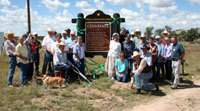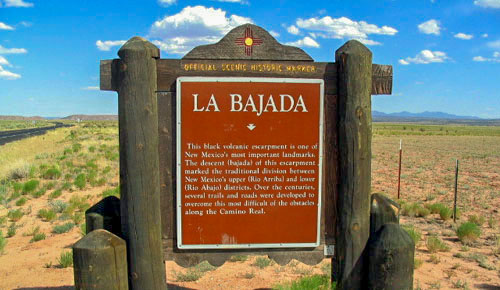How They got Started
When Americans took to the road, many states devised ways to attract motorists off the highway, explore, and invest some time and money learning about local cultures and landmarks. In 1935, New Mexico—no stranger to promoting tourism with its history—began installing those signature big, brown, log-hewn signs to inform travelers about the landscapes and the people who inhabited them.
Official Scenic Historic Markers explain land formations, public archaeological sites, important buildings, historic travel routes, places, and events. They mark locations of geologic, cultural, economic, political, scientific, and artistic significance to New Mexico, the Southwest, and the nation.
From El Camino Real to Route 66, from record producers to recording stars, from prehistoric civilizations to the first atom bomb, historic markers cover the broad and diverse history of the Land of Enchantment.
Markers memorialize Native American warriors, Spanish conquerors, and some outlaws. Women’s role in history was seldom mentioned until 2007, and now is illustrated on 75 historic markers. Travelers will discover ghost towns, battlegrounds, and utopian settlements no longer inhabited by a soul.
To get an idea of what New Mexico’s approximately 650 historic markers are all about and where to find them, use the Official Scenic Historic Marker Guide, the most complete database available of New Mexcio's markers. Many of the markers are also found on websites and smartphone apps.
New Mexico is vast and often remote. If you find a marker that time and the elements have rendered illegible, or is significantly damaged, please contact the historic marker coordinator. Please send GPS coordinates if you can.
Tips for Preparing a Successful Marker Application
Most marker nominations originate with the public or an organization. Generally, nominations are successful when the subject of the proposed marker relates to a specific location, place, or feature, and prompts would-be readers to think about their immediate surroundings. Potential applicants should note that interesting or important historic subjects in family, local, county, or even state history do not necessarily meet the threshold for eligibility or significance under the established regulations and standards for the Official Scenic Historic Marker Program.
The crux of a successful nomination is the proposed marker text. Applicants should rely on substantial, evidence-based research to carefully craft a short history of the subject and clearly make the case for its significance. Keep in mind that writing short, informative histories is challenging. Applicants are encouraged to reach out to the program coordinator to discuss proposed marker eligibility and potential text.
The program coordinator, in consultation with other HPD staff, reviews each application and forwards eligible marker applications to the Cultural Properties Review Committee (CPRC), which ultimately approves them. While applicants can propose a marker location, the New Mexico Department of Transportation, in consultation with the CPRC, determines final locations based on highway safety, rights-of-way, and space requirements. Before applying, first please review the regulations and standards. Then, consider if the proposed marker in mind fits the bill, contacting the program coordinator as needed. Finally, download the form, complete it, and submit it via email to the program coordinator.
Contact
Questions? Please contact Matt Saionz at matt.saionz@dca.nm.gov.





